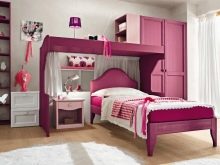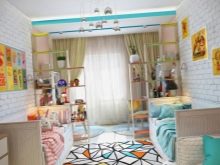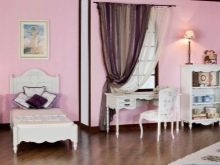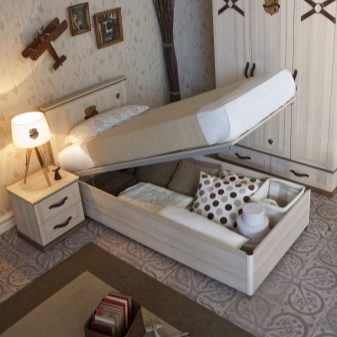Children's single bed: types, models and design

In any family there comes a time when the child has already outgrown his baby cradle and needs to equip a new sleeping place. One of the most convenient options for children's furniture is a single bed, which will provide comfort and serve for a long time.
It is important to choose the right model and material of the bed, because a high-quality bed is the key to a healthy spine of the child.



Advantages and disadvantages
Buying a full bed for a son or daughter is quite serious, because high-quality furniture is not cheap. It has significant advantages over various compact sofas or folding chairs, and over a massive double bed.
- It is easier to place it in a small room, especially if the room has an elongated rectangular shape. Such a bed can be attached to the wall and it will not create difficulties when changing linen. If it only touches the wall with the headboard, you can get up and lie down from either side.
- If there are two or more children, several single beds are preferable to one double. Babies will not interfere with each other in their sleep, pull off the blanket or crush their younger brothers and sisters with their weight.



- Unlike various armchairs and sofas, even for the smallest crib, you can choose a high-quality orthopedic mattress. Such a mattress will not only allow you to sleep better, but also relieve unnecessary stress on the spine.
- Such a bed can be more easily supplemented with various functional mechanisms, which is especially important for parents with children with disabilities or problems with the spine.
Of the minuses of a single bed for children, only one can be distinguished - this is that the child grows quickly and the furniture can become "small" for him. However, this problem is easy to solve.
It is necessary to initially buy furniture with the expectation that the son or daughter will grow up quickly, therefore, select the optimal sizes that will suit even an adult.



Types of cots
Besides the fact that there are beds for adults and children, the children's furniture itself is also classified according to the age of the child.
There are single beds:
- for infants and children up to 2-3 years old (cradle, bed-playpen);
- for preschool children from 2 to 6 years old;
- school furniture;
- furniture for a teenager.
The shape of a single bed can be:
- classic rectangular;
- oval with rounded corners (which is especially important for the parents of a little fidget that touches all corners);
- design options in the form of various cars, spaceships, carriages and more.



Depending on the material of the frame, the furniture can be:
- wooden - the most preferable option for a child: it is environmentally friendly and safe, the main thing is that it is carefully polished and does not put splinters;
- metal - such models must be covered with anti-corrosion substances that can be dangerous for small children;
- combined - in these structures, metal legs can be connected to a wooden frame;
- with plastic or glass inserts - these beds are better left for adults, because plastic bends easily, and glass can crack and injure a baby.
In addition, a bed for a child can be either with a solid base in the form of a simple box, or in the form of wooden slats inserted into special holders attached to the frame. For the child's spine, the second option is most preferable, since it gives an additional orthopedic effect.
In addition, with such a base, the mattress is better ventilated, which is especially important for those parents whose children are still peeing in their sleep due to their age.


Depending on the appearance and functionality, you can also divide the single beds into several types.
Classic
Most often it is an ordinary rectangular bed with legs or a flat base. Externally, it can be decorated with plywood or boards and look like a boat, car and any transport or object, but inside there is a regular rectangular frame with a mattress laid on it.



With drawers
These beds combine the functions of a bed and a wardrobe. The free space under the bottom is occupied by one or more hollow pull-out boxes, which can easily accommodate additional pillows, blankets or bedding.



With lifting mechanism
This model is similar to a bed with drawers, only they do not slide out from under it.
To access them, you need to raise the bed itself, under which storage space will be found.


Podium bed
Such a bed does not have legs, but is located directly on the floor on a small elevation. Most often, it is mounted in large, spacious rooms, since it requires a lot of space.
On the podium itself, you can also place various boxes and niches for storing things.


Loft bed
These beds, on the other hand, are convenient for use in very limited spaces. The bed itself is located on high legs at a distance of 1/3 from the ceiling. A small wooden or metal ladder leads to it.
The space under the bed can be used under a table, play area or small wardrobe.



Sofa bed
Such a folded bed resembles a small sofa with soft handrails and a back. Its size is quite modest, so it is suitable for a child no older than 12-14 years old.


Sofa bed
Outwardly, such a bed is very similar to a sofa bed, however, it is expanded not in width, but in length. This will allow even an adult to use the sleeping place, and not just a child.

Furniture sets with built-in bed
These are large multifunctional structures that can be either with a hidden or an open bed. Most often this is a combination of large wardrobes with a desk, which in the evenings turns into a neat baby cot.
Such mechanisms are very convenient for schoolchildren in confined spaces.


Optimal dimensions
It is best to choose a standard sized bed, as it will be easier for them to select mattresses. Ready-made orthopedic mattresses are much cheaper than those made to measure.
Classic beds are available in the following sizes.
- Width - 100, 90, 80 and 70 cm. Children's bed most often has a size of 70 to 90 cm in width. Furniture over 90 cm wide is considered a teenage or adult bed. A bed 140 cm wide is already considered one and a half;
- Length - 200, 195 and 190 cm. Obviously, the longer the bed, the more years the child will be able to sleep comfortably on it. A bed 200 cm long is considered an adult option.
Most often, such models of sleeping places are produced, which have dimensions 90x200 and 90x190.
If there is free space in the room, it is better to choose the first option, since it is most comfortable for both a preschool child and a teenager.



Popular models
Today, both large furniture companies and small private industries produce single beds for children in many different colors and shapes.For girls, softer tones and pastel colors are selected, while boys prefer sharper shapes and bright colors. Wooden furniture of natural color and texture will fit into any interior and will remain relevant even after the child grows up.
With all the variety of color solutions, the most popular are models in white, beige and dark brown. They are ideally combined with any colors and finishes of walls and floors, it is easier to choose bedding for them. Nevertheless, the main selection criterion remains the comfort and preferences of the child himself.
Tips for choosing a bed - in the next video.













The comment was sent successfully.